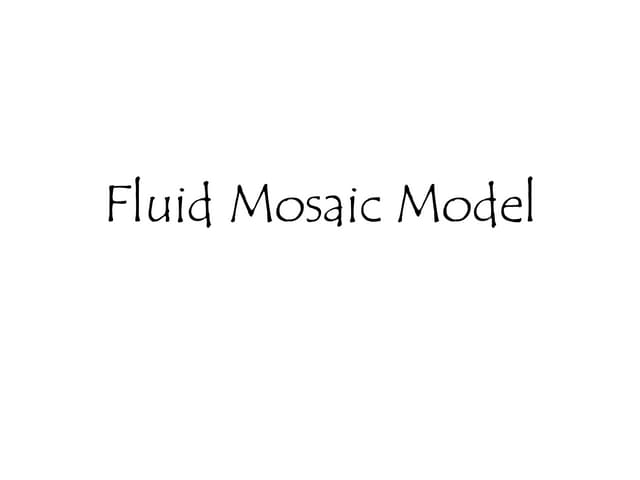
Nicolson in 1972, describes the cell membrane as a two-dimensional liquid that restricts the lateral diffusion of membrane components. The biological model, which was devised by Seymour Jonathan Singer and Garth L.

Small amounts of carbohydrates are also found in the cell membrane. The phospholipid bilayer gives fluidity and elasticity to the membrane. According to this biological model, there is a lipid bilayer (two molecules thick layer consisting primarily of amphipathic phospholipids) in which protein molecules are embedded.
 The presence of a cell wall prevents the membrane from bursting, so cytolysis only occurs in animal and protozoa cells which do not have cell walls.The fluid mosaic model explains various observations regarding the structure of functional cell membranes. Where water moves into the cell by osmosis where the volume exceeds the membrane's capacity and the cell bursts. Cytolysis, or osmotic lysis, occurs when a cell bursts due to an osmotic imbalance that has caused excess water to move into the cell. As a result the cell shrinks and forms abnormal notchings around its edges. Crenation occurs because in a hypertonic environment, osmosis. Crenation is the contraction of a cell after exposure to a hypertonic solution, due to the loss of water through osmosis. The Shrinking of cell membrane from cell wall in a plant or bacterial cell, caused by loss of water through osmosis. Is pressure on inside of a cell against the cell wall. Is a hydrostatic pressure due to a plant cell being placed in a hypotonicsolution. The pressure of water moving across a membranes cause by a concentration gradient. The phospholipid in the membrane are in a fluid state which allows the cell to change it’s shape easily. The phospholipidbilayer makes the membrane very stable but also allows flexibility. Cell membranes are made up of a double layer of these phospholipid molecules. They have a hydrophilic phosphate head and two hydrophobic hydrocarbon tails. Hydrophobic (not attracted to water but are attracted to other hydrophobic tails).
The presence of a cell wall prevents the membrane from bursting, so cytolysis only occurs in animal and protozoa cells which do not have cell walls.The fluid mosaic model explains various observations regarding the structure of functional cell membranes. Where water moves into the cell by osmosis where the volume exceeds the membrane's capacity and the cell bursts. Cytolysis, or osmotic lysis, occurs when a cell bursts due to an osmotic imbalance that has caused excess water to move into the cell. As a result the cell shrinks and forms abnormal notchings around its edges. Crenation occurs because in a hypertonic environment, osmosis. Crenation is the contraction of a cell after exposure to a hypertonic solution, due to the loss of water through osmosis. The Shrinking of cell membrane from cell wall in a plant or bacterial cell, caused by loss of water through osmosis. Is pressure on inside of a cell against the cell wall. Is a hydrostatic pressure due to a plant cell being placed in a hypotonicsolution. The pressure of water moving across a membranes cause by a concentration gradient. The phospholipid in the membrane are in a fluid state which allows the cell to change it’s shape easily. The phospholipidbilayer makes the membrane very stable but also allows flexibility. Cell membranes are made up of a double layer of these phospholipid molecules. They have a hydrophilic phosphate head and two hydrophobic hydrocarbon tails. Hydrophobic (not attracted to water but are attracted to other hydrophobic tails). 
Hypertonic Solution Plant Cells Animal Cells What will happen to this cell? H2O Cell Shrinks Who has more solute? What type of solution is this cell in? Hypertonic solution Cell solute solvent.Understanding solutions Hypotonic solution Hypertonic Solution solute solvent Is when there is an uneven distribution of a substance across a solution.A combination of a Solute and Solvent.

Phospholipid fluid sea in embedded with a wide variety of protein molecules. Current model of the membrane structure.








 0 kommentar(er)
0 kommentar(er)
